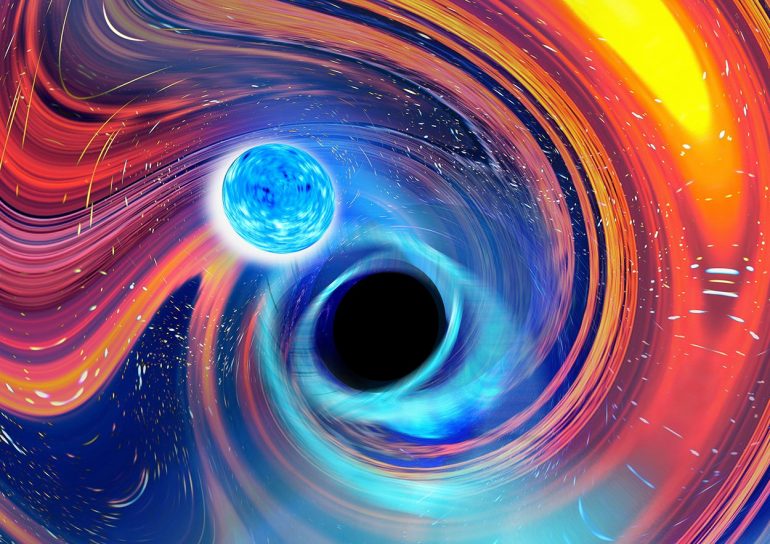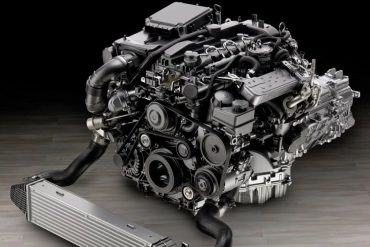After several as-yet-unexplained candidates, astronomers have now captured the apparent gravitational wave signal from the collision of a neutron star with a double black hole. In these events, about a billion light-years away, a stellar black hole devoured a smaller, lighter neutron star, releasing energy vibrating space-time. In January 2020, the LIGO and Virgo observatories captured these vibrations in the form of gravitational waves. The data now provides valuable insight into the circumstances of such disparate mergers and their history.
Since the commissioning of the two LIGO gravitational wave detectors in the United States and the European Virgo detector in Italy, astronomers have captured the specific gravitational wave signatures of a cosmic collision more than 50 times. Mostly it was a merger of two stellar black holes. In 2017, the detectors also recorded for the first time the collision of two neutron stars, which are extremely dense remnants of massive stars. However, what was missing until now was the observation of mixed collisions: “Gravity waves made it possible for us to detect the collision of pairs of black holes and pairs of neutron stars, but the collision of a black hole with a neutron star merger The missing piece was in the family photo of compact objects,” explains co-author Chase Kimball, of Northwestern University in Evanston. Although there were some gravitational wave phenomena that were considered candidates for such a “mixed pair”, the state of the data was not clear enough.
two mixed collisions in a row
This has changed from January 2020. Because only ten days apart, gravitational wave observatories detected two events that astronomers attributed to the collision of a neutron star with a black hole. The GW200105 event was captured on January 5, 2020 by the LIGO detector in Livingston and the Virgo detector in Italy, but in the latter case the signal was only weak and therefore difficult to filter out from background noise. “Even though we only see a strong signal from one detector, it is real and has passed all our quality tests,” emphasized Harald Pfeiffer of the Max Planck Institute for Gravitational Physics in Potsdam. Analyzing the data, it appears that the signal comes from about 900 million light-years away and was caused by the merger of a black hole with nine solar masses and a light object with a mass of 1.9 solar masses.
“Gravitational waves alone do not tell us the structure of a lighter object, but we can determine its maximum mass,” explains Pfeiffer’s colleague Bhushan Gadre. “By comparing this information with theoretical predictions for neutron star mass in such binary systems, we can conclude that a neutron star is the most likely explanation for another object.” This second event is confirmed by GW200115, which occurred on January 15, 2002 by both the LIGO detectors and the Virgo detector. This gravitational wave signal also comes from the unequal collision of a black hole and a neutron star, as astronomers report. A black hole with six solar masses and a neutron star with 1.5 solar masses were involved in the merger, which is about a billion light-years away. Using the triangle, the scientists were able to narrow down the position of this event to a region of the sky that corresponds to the size of about 3,000 full moons.
The neutron star was swallowed whole
Soon after the gravitational wave signals were detected, further teams of astronomers were alerted, looking for possible electromagnetic signs of collisions in the corresponding region of the sky – for example in the form of bursts of rays. However, they got nothing. Researchers attribute this to the great distance and the fact that the neutron star was probably swallowed whole by the black hole. “These were not events in which black holes first nibble on neutron stars and throw debris around them like cookie monsters,” explains LIGO spokesman Patrick Brady of the University of Wisconsin-Milwaukee. “This ejection would generate radiation, but we don’t think that’s what happened in these cases.” Co-author Susan Scott of the Australian National University says: “It’s more like PacMan: the black hole’s neutron star partner is swallowed whole.”
As the astronomers point out, the evidence for these mixed collisions now offers new opportunities to explore the formation, evolution and end of such mixed pairs in more detail. “There’s a lot we don’t know about neutron stars and black holes — how small or large they can be, how fast they spin, how they combine,” explains Northwestern University’s Maya Fischbach. “With more gravitational wave data we will get the data we need to answer these questions and learn more about the most extreme objects in our universe.” The LIGO and Virgo crews are currently optimizing their detectors to complete the next observation round in the year 2022 to achieve even greater sensitivity. As the third member of the group, the Japanese Kagra Detector is also operating from 2020.
Source: LIGO and Virgo Collaboration; The Astrophysical Journal Letters, doi: 10.3847/2041-8213/ac082e

Web guru. Amateur thinker. Unapologetic problem solver. Zombie expert. Hipster-friendly travel geek. Social mediaholic.





